Ospreys in South Australia
Friends of Osprey work on GPS tracking and banding Ospreys as well as live streaming wild Ospreys in South Australia
Our ospreys
Friends of Osprey operated informally before our official formation in March 2022. During that time we began following a number of birds, some of which were banded or GPS tracked, or both.
The GPS tracking has been a game changer for developing our understanding of osprey in South Australia and while the story hasn’t always had a happy ending, our knowledge of what’s happening with ospreys and where they go when they fledge has been dramatically improved.
This enhanced understanding will help us make decisions which should ensure the improved conservation of the species. Below is a list of nesting sites that we monitor and information on the birds that have fledged from these nests.
Port Lincoln barge nest, Eyre Peninsula
The nest that was the catalyst for much of our work and the community’s interest is found in Proper Bay, a commercial fishing port and marina in Port Lincoln on South Australia’s Eyre Peninsula. Two ospreys began nesting on an abandoned barge in 2016 and have successfully fledged young ever since.

Calypso, female, 2019 – present day
Calypso has not gone too far from home since fledging from the barge in 2020, spending time around Port Lincoln and appears to now have paired up with another bird at Tulka near Lincoln National Park, a few kilometres away from the urban area. An elevated platform has been established there (with financial support from Birds SA) and Calypso and another unidentified osprey have been seen roosting and apparently establishing a territory there.
Calypso is not satellite tracked, but is banded, enabling birders with high quality binoculars or photography equipment to identify her.
Band identification: Blue band on left leg, metal (silver) on right leg.
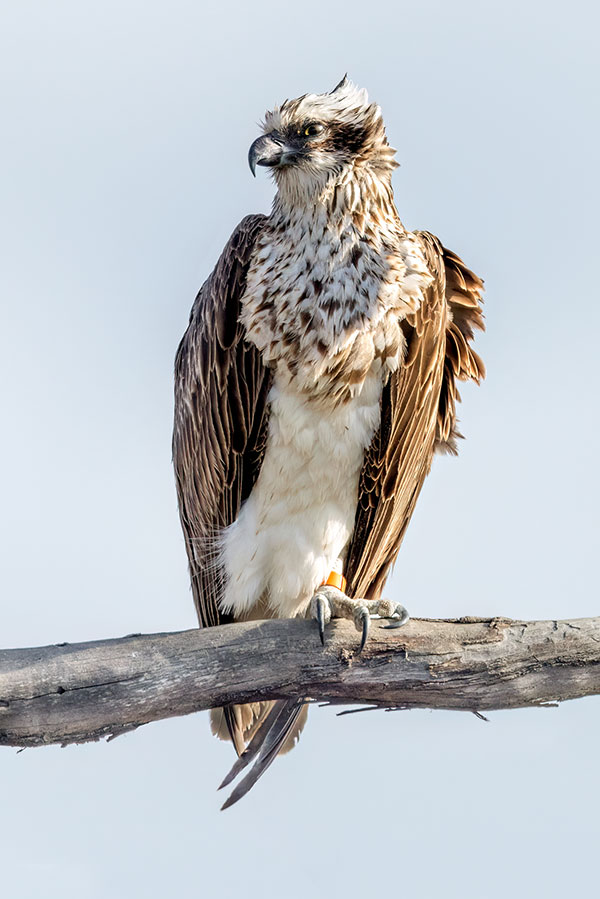
Solly, female, 2020 – 2021
One of our most iconic birds to date, Solly was named after Fran Solly, the Secretary of Friends of Osprey and a passionate Port Lincoln birder. Solly fledged from the Port Lincoln barge nest in early 2021. When she left the nest, she flew north to Eba Anchorage near Streaky Bay on the west coast of the Eyre Peninsula. The tracker provided a surprising insight into the path she took, heading through the centre of the peninsula, passing through protected areas of native vegetation on her journey.
For nine months she foraged around Eba Anchorage and was maturing into a beautiful bird with a significant local following. Sadly, in a stroke of great misfortune, she was electrocuted on a faulty electrical pole in late 2021. While this was a sad outcome, Solly helped to significantly raised awareness of Osprey on the Eyre Peninsula and again without the tracking device so much would not have been learnt, nor would her body have been recovered or her cause of death known.
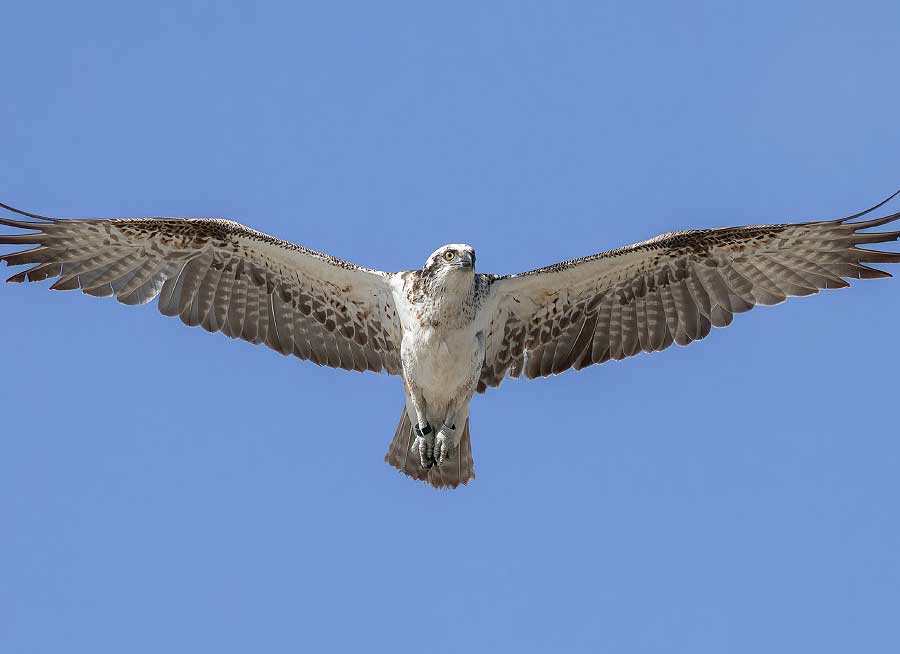
Ervie, male, 2021 – present day
Named by Chair of Friends of Osprey, David Speirs, after his childhood home parish in Scotland, Ervie was one of three brothers (the same as David!) to fledge from the Port Lincoln barge nest in early 2022. Interestingly, he has stayed much closer to home than any of the nest’s previous fledglings, remaining in and around the nest many months after his brothers had left the area (they are not tracked and have not been seen since shortly after fledging).
While Ervie is satellite tracked, his journeys are short and not particularly adventurous. It will be interesting to see if he is pushed further away from Port Lincoln as he matures and looks for a partner and territory.
Band Details: Metal (silver) on the left leg and dark green on the right leg.
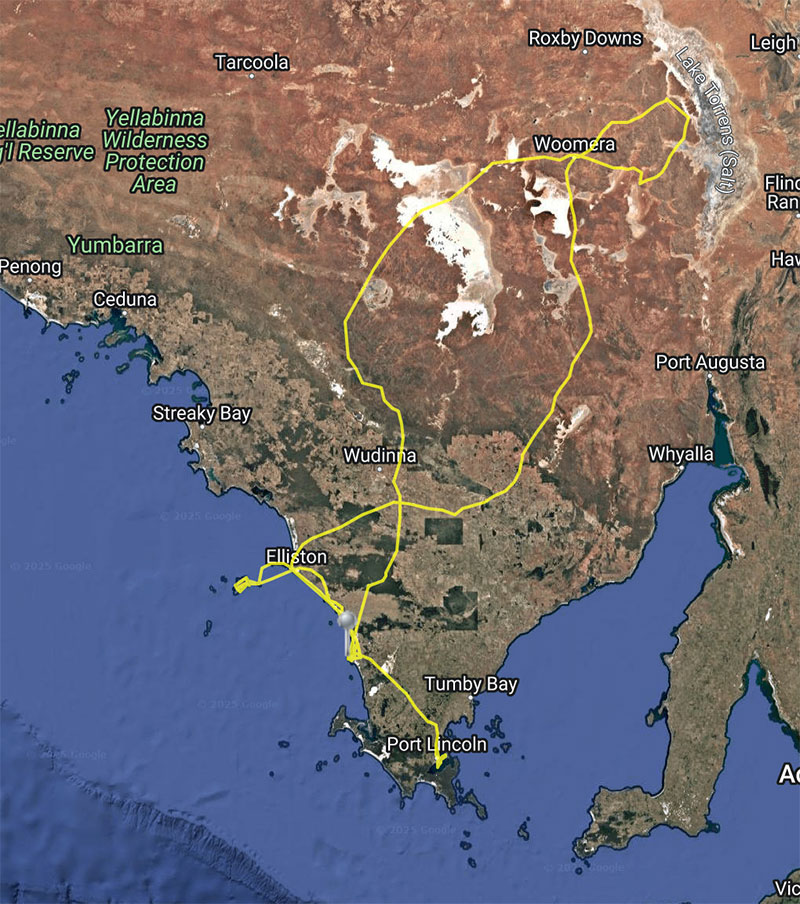
Zoe, female, 2022 – likely deceased
Named for Friend of Osprey patron, Janet Foster’s, granddaughter who has also embraced her grandmother’s love of osprey, especially when a perch erected in front of their home had two birds regularly roosting overnight.
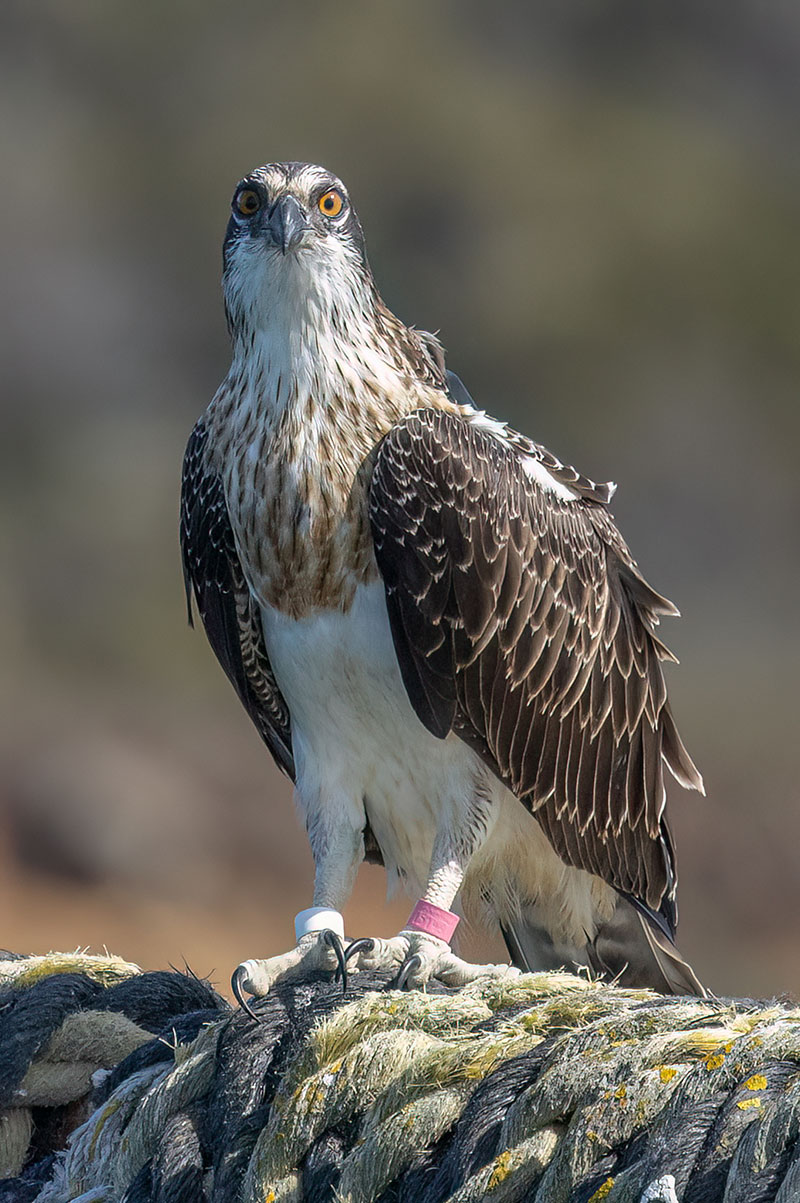

Giliath, male, 2023 – present day
Named after by Bart Molenaar an avid support of Friends of Osprey based in The Netherlands. Giliath has stayed close to his home nest since fledging in early 2024. This behaviour is similar to other male birds that have fledged from the Port Lincoln barge nest, suggesting that male birds are less adventurous, at least in the early years, than their female counterparts.
Band identification: Pink on the left leg, white on the right
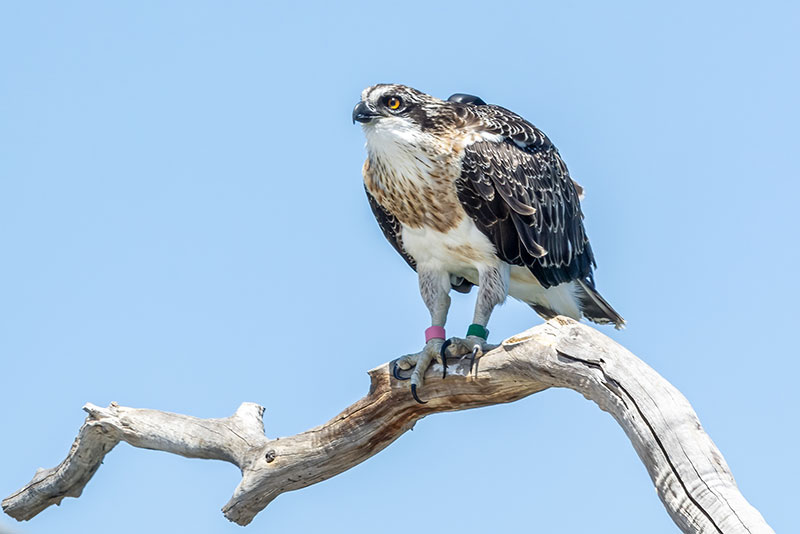
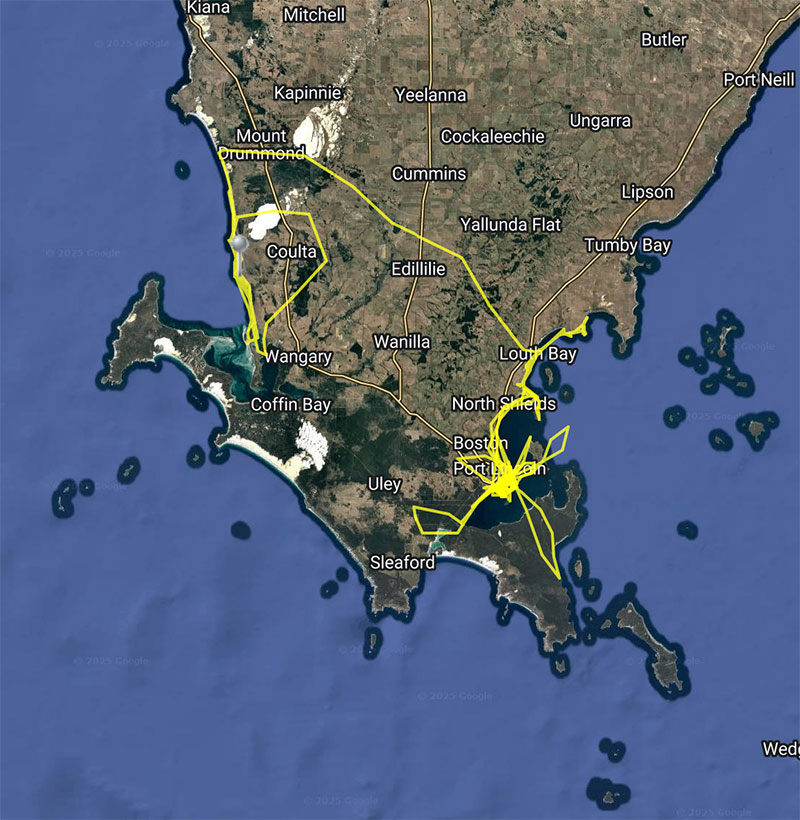
Wilko, male, 2024 – present day
One half of a brother and sister duo fledged on the Port Lincoln Barge in early 2025, this bird has been named after National Parks and Wildlife Service ranger, Peter Wilkins. Peter has been an active supporter of the work done by Friends of Osprey over several years, especially on Eyre Peninsula.
Wilko left the nest area in February 2025 and was last reported near Frenchman’s Bluff on the western side of Eyre Peninsula. He is satellite tracked.
Band identification: Green on the left leg, pink on the right.
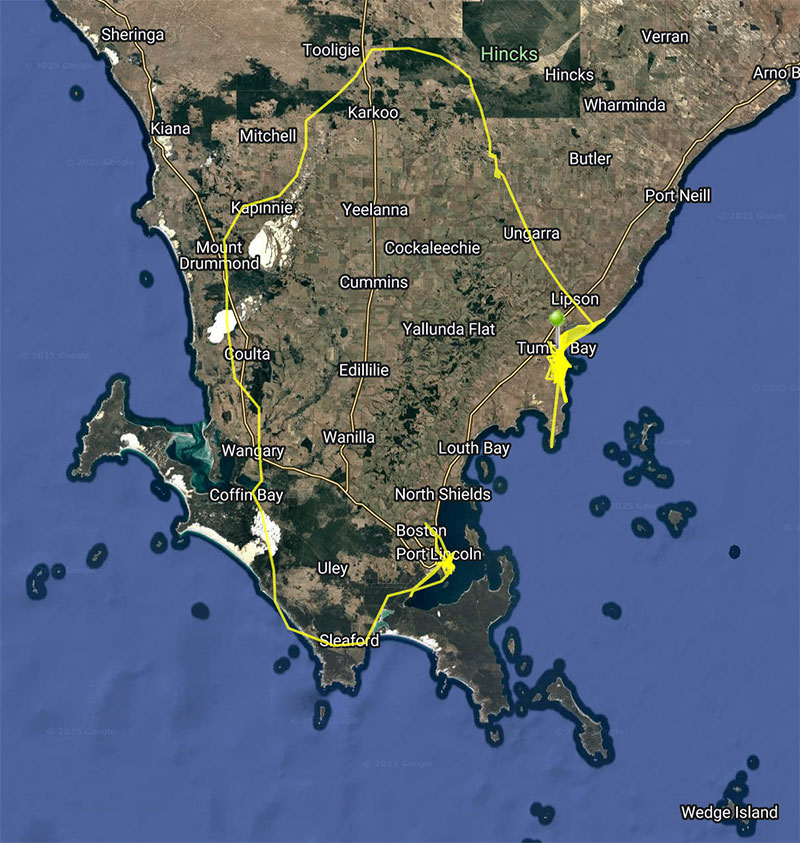
Kasse, female, 2024 – present day
Named after Port Lincoln local and Friends of Osprey supporter, Ross Kassebaum, this was the second bird to be ringed and tracked from the Port Lincoln barge nest in 2024.
Kasse like many of the female birds flew north to the interior of the Eyre Peninsula, South Australia, but fortunately quickly returned to the coast and has been spending time around Tumby Bay on the south east of the peninsula.
Band identification: Red on the left, white on the right.
Tumby Island, Eyre Peninsula

Sandy-Blythe (Sandy), female, 2024 – present day
Friends of Osprey at Tumby Bay have named the first bird to fledge from the Tumby Island artificial nesting platform for islands in the Sir Joseph Banks Group, an archipelago off the coast of the Eyre Peninsula, east of Tumby Bay. Sandy-Blythe is a small sandy quay hugely popular with locals.
Sandy has a GPS tracker and to date has spent most of her time close to home.
Band identification: Yellow on the left and black on the right.
Gleesons Landing, Yorke Peninsula
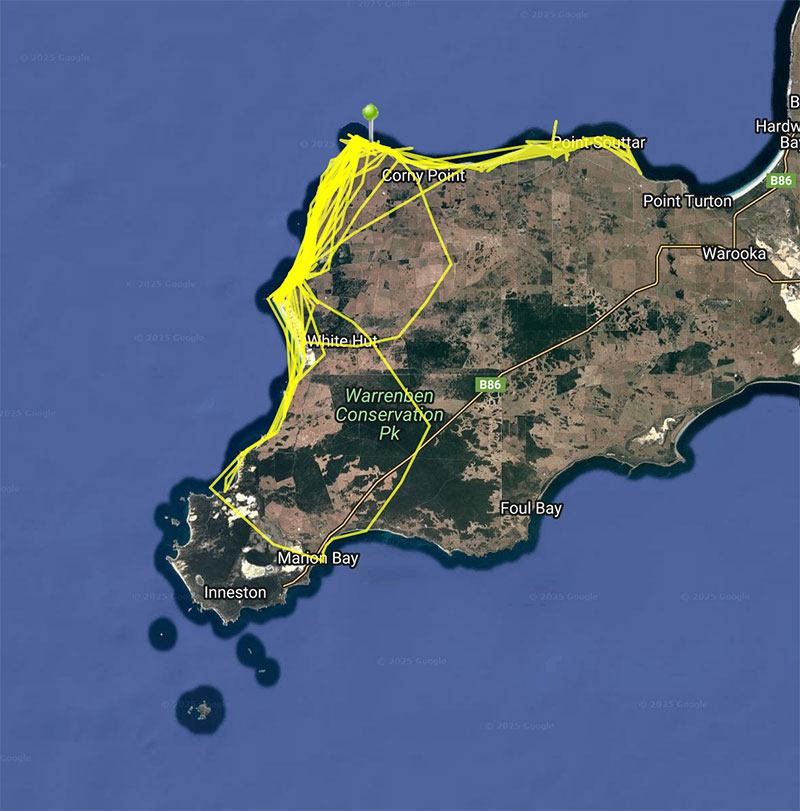
Hector, male, 2024 – present day
Hector was named for a surf break next to Gleesons Landing where he fledged from the artificial platform installed there. This name was given as an acknowledgement of the surfer volunteers of the Formby Bay Environmental Action Group and the Daly Head National Surfing Reserve that helped install the platform.
Hector has a tracker and has been stayed fairly close to the nest site since fledging.
Band identification: red on left, blue on right
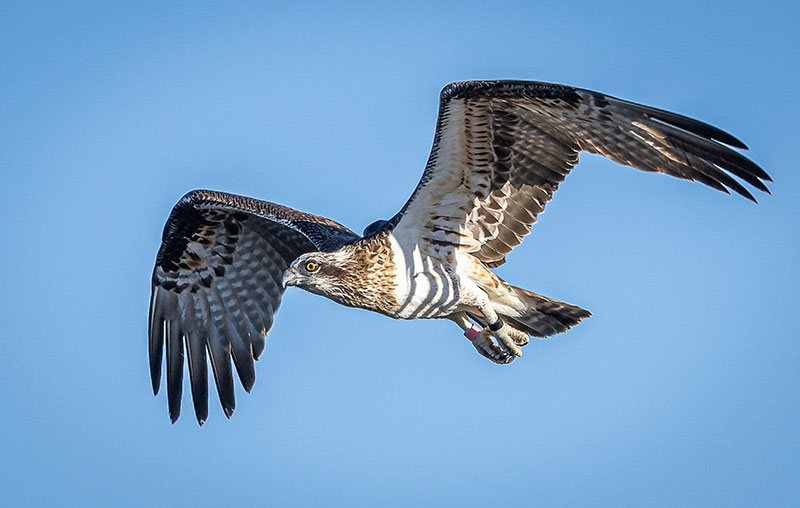

Annie, female, 2024 – present day
Annie is named after a local landmark, Point Annie, which is found between Gleesons Landing and Corny Point on the southern Yorke Peninsula. This name was also suggested by Formby Bay Environmental Action Group.
Band identification: black on left, pink on right
Coobowie, Yorke Peninsula
The nesting platform at Coobowie on the southern Yorke Peninsula was installed in 2024 to replace a natural nest that had been inappropriately sited on a nearby telecommunications platform. It is located several hundred metres offshore near the township of Coobowie and not far from the Coobowie Aquatic Reserve with its swampy mudflats and shallow waters, ideal foraging grounds for osprey.
Within hours of the platform being installed, the adult birds from the telecommunications tower had taken up residence and in 2024 hatched eggs, three of which fledged, a phenomenal result.

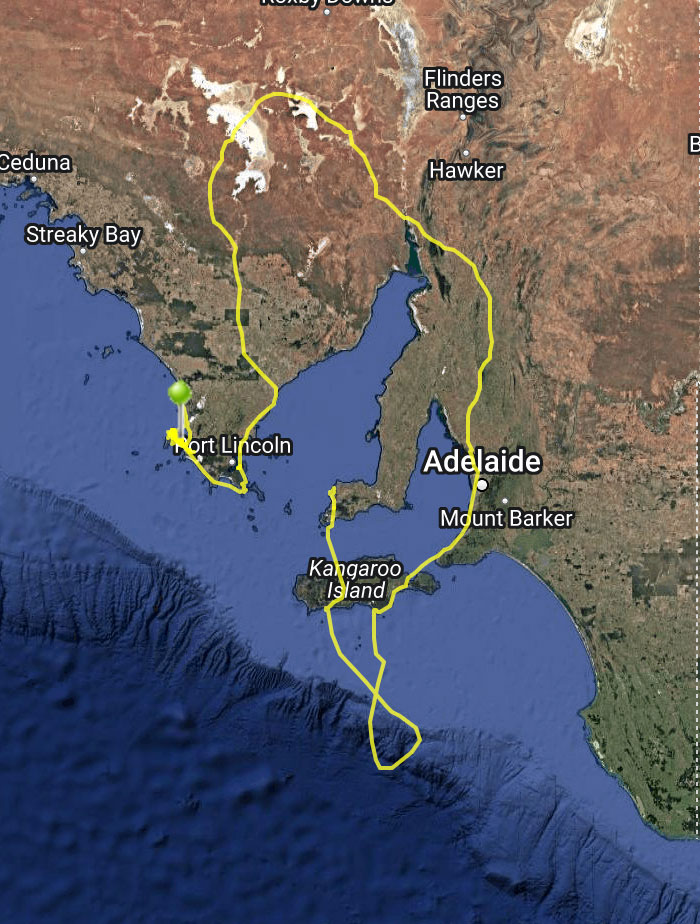
Marie, female, Coobowie – 2024
Marie takes the prize for the most interesting biography that a Friends of Osprey tracked bird has to date.
She was banded and tracked at the Coobowie nest in late 2024 but within days found herself in strife when she prematurely fledged from the nest and was found flailing about on the rocks by avid osprey photographer Dave Weatherall. She was rescued and things looks quite bleak for her, but her troubles coincided with a visit by renowned Scottish conservationist Roy Dennis. Roy was able to force feed Marie (in the same way that her parents would do) and he advised Friends of Osprey to relocate the young bird to another nest rather than take the risk of disturbing and potentially scaring Marie’s siblings from the Coobowie nest, least they face the same fate as her.
The banding and tracking of young at the Gleesons Landing artificial platform was scheduled for the next day, so Marie was taken there and fostered into that nest. Within a short period of time the mother osprey at Gleesons Landing was feeding Marie and the fostering process has proven successful.
Marie left Gleesons Landing on 16 February 2025 and began an epic flight which took her a short hop over the sea to Kangaroo Island, before she proceeded to travel 380 km from Cape Bouger on Kangaroo Island to the Continental Shelf and back again, before heading back to the mainland South Australia. She then made a 66 hour, 824 km trek from the north of Adelaide to the dry pastoral country in the state’s interior, reaching Lake Gairdner near Woomera, then turning southward again, back to the Eyre Peninsula and eventually the coast at Port Neill. Her tracker revealed that her maximum speed was 69.7 km/hr and average speed was 6.8 km/hr. Average elevation was 100 metres and maximum elevation 633 metres over the Flinders Ranges.
Marie has since travelled across the southern Eyre Peninsula and taken up residence in Coffin Bay National Park.
A side note, sadly the mother bird from the Coobowie nest (Marie’s mother) disappeared shortly after Marie’s two siblings fledged (while they were still largely dependent on their parents for food) disappeared and is almost certainly dead. Serendipitously, if Marie hadn’t been relocated to Gleesons Landing, she may well have starved, the likely fate of at least one of her original Coobowie siblings.
Band identification: Red on left, white on right.

Libby, female, Coobowie, 2024 – present day
Libby was named for Coobowie local and osprey conservation supporter Libby Haywood. Libby’s husband, Wayne, assisted in the installation of the platform.
Their house is situated where they have a complete view of the platform and its surroundings from inside of their house and they monitor all activity and report if there is anything of concern that needs attention.
Libby (the osprey) was one of three birds to fledge in the first year of breeding at the Coobowie nesting platform and has been spending time in and around the nesting site since early 2025.
Band identification: metal (silver) on left and pink on right
Missy, female, Coobowie, 2024 – status unknown
Missy is one of three sisters to have fledged from the Coobowie nest in late 2024. She is named for Malcolm Stanton whose initials are MIS. Given Missy’s gender, it was thought inappropriate to call her Malcolm! Malcolm has been a stalwart support fo the osprey conservation work being undertaken on the Yorke Peninsula and he and his wife Marie (who Marie the osprey is named for) are informal guardians of the Coobowie platform.
Missy’s mother went missing before she was fully independent and Missy disappeared shortly thereafter. It is likely, but unconfirmed, that Missy’s father was not able to provide enough food for her and her sibling, Libby, but will go unknown for certain.
Band identification: red on left, pink on right
Thistle Island, Eyre Peninsula
The Thistle Island nest is a natural nest on a rocky outcrop on Thistle Island, a small island off the east coast of the Eyre Peninsula. It has been a productive osprey nest for many years and has been monitored by Friends of Osprey in recent times.
Bluey, male, 2020 – status unknown
Named after the father of the Chair of Friends of Osprey, David Speirs, (Bluey is his dad’s nickhame), this bird fledged from the Thistle Island nest in early 2021. It has not been seen since and its status remains unknown.
Meg, female, 2021 – 2022
Fledgling from a historically successful nest on Thistle Island, a small island off the east coast of the Eyre Peninsula, Meg was fitted with a satellite tracking device on 8 November 2021, becoming independent from her parents on 18 February 2022 and heading off on a huge flight over 19 days. This flight took her east to the Yorke Peninsula, before making a flight of several hundred kilometres north to Wirrabara in the Southern Flinders Ranges, a significant distance inland from the coastal areas we so frequently associate with Osprey. She flew around the regional town of Crystal Brook, before making her way back to the coast at Port Broughton and Wallaroo, then arriving at Dhilba-Guuranda Innes National Park on the foot of the Yorke Peninsula. At this point she ceased moving and was subsequently found dead. A post mortem undertaken by the University of Adelaide’s Veterinary Facility showed that she had died of starvation, perhaps having never managed to successfully hunt from the point she left her parents and went on her huge flight.
While this was a sad ending for Meg’s short life, the extent of her journey and the discovery of her body would never have been possible without the use of the tracker.
Lucy
Named for a young follower who was having a birthday on the day that Lucy hatched and was watching via the YouTube live feed. This bird was not banded or tracked.

Ronnie, female, 2022 (status unknown)
Named after the late husband of Friends of Osprey patron, Janet Forster, Ronnie fledged from the Thistle Island nest in early 2023, and was last recorded in the lower Flinders Ranges. She has not been reported since.
Band identification: Silver on the left, black on the right.
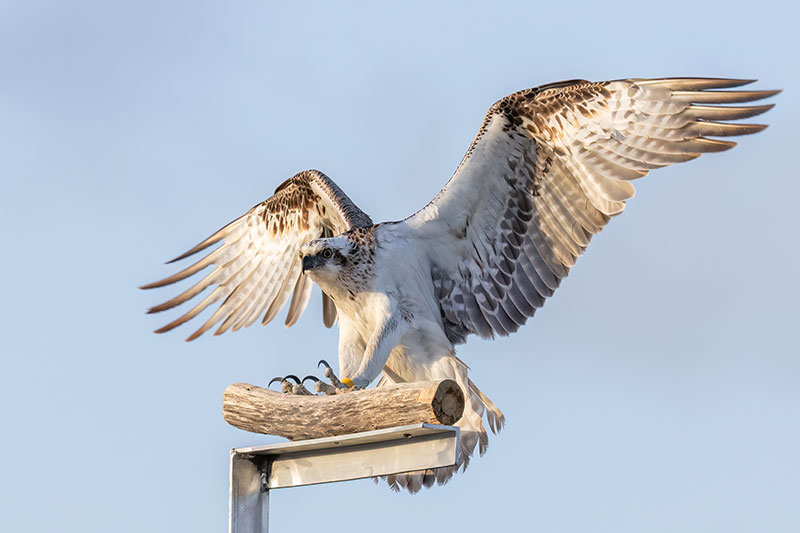
Schutzie, male, 2023 – present dayStatus Unknown
Fledging from the Thistle Island natural nest in early 2024, this osprey was named for John Schutz, the head of South Australia’s Department for Environment and Water between 2018 and 2024. John has had a lifetime working in conservation and has been very supportive of the work of Friends of Osprey.
Unfortunately Schutzie’s GPS tracker failed shortly after he fledged, however he is was able to be identified through his leg band and is was regularly seen around the city of Port Lincoln on the Eyre Peninsula up until December 2024. There have been no recent sightings..
Band identification: Yellow on left, white on right
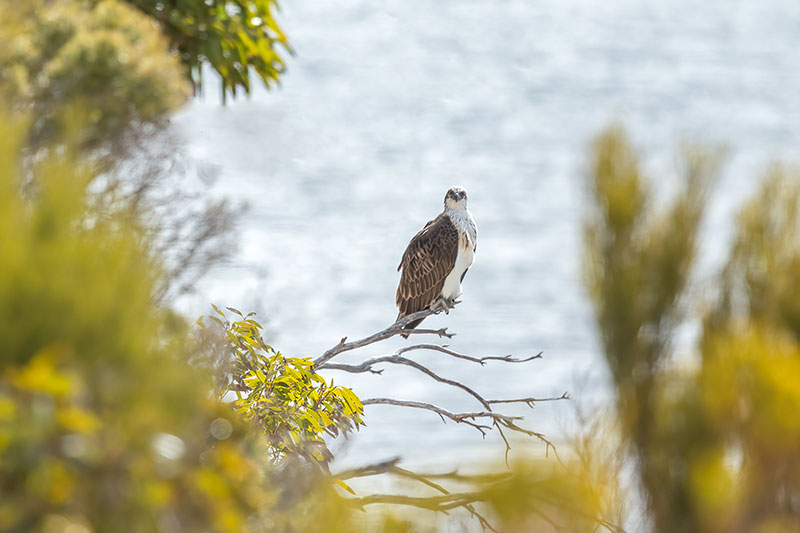

GT, male, 2024 – present day
Named for Graham Tapley who has supported Friends of Osprey with transport to and from the Island since 2022. Graham has also kept an eye on the nest providing regular reports as to the status of breeding.
GT was one of two chicks to fledge from the nest in 2024, the other which had already fledged by the time Friends of Osprey visited the site. GT is known to be in the Lincoln National Park area.
Band identification: Red on the left, black on the right.
Price, Yorke Peninsula
The artificial nesting platform near the township of Price on the northern Yorke Peninsula is located in Wills Creek Conservation Park, an area dense in mangroves and meandering waterways. It was first installed in 2021 to replace a nest precariously balanced on a nearby navigation marker, with the aim of giving a more secure and permanent nesting spot for a pair of ospreys that had been in the area for some years.
The nest has proven highly productive, successfully producing young each year. The ospreys have become minor celebrities in the Price community and have inspired a range of local activities. The nest is currently the closest known osprey nest to metropolitan Adelaide.
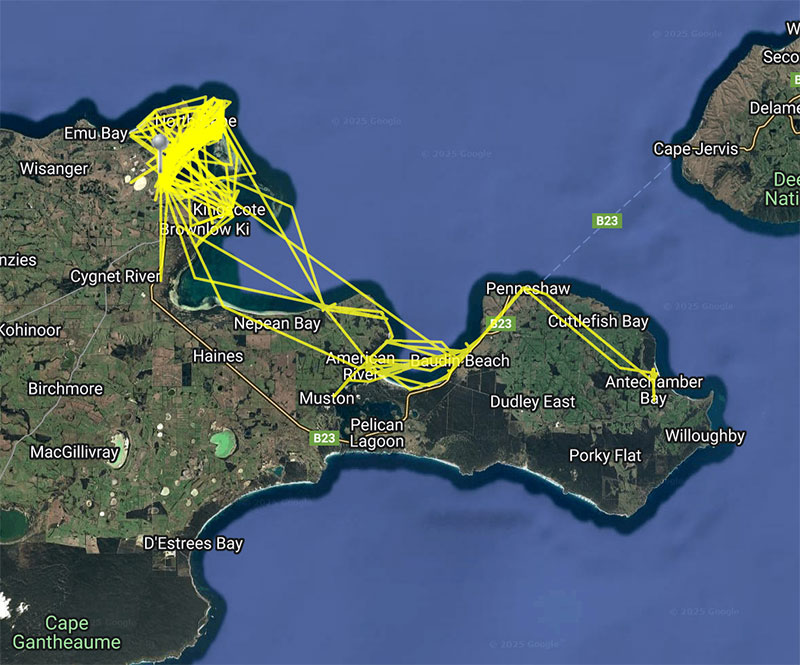
Phantom, female, 2021 – present day
Phantom fledged from the Price nest in early 2022 and was named after Price local Malcolm Walker, who has volunteered as skipper assisting Friends of Osprey volunteers access the Wills Creek nest since 2021 when the artificial nesting platform was first installed. Malcom is in his late 80s and can be seen on most days in his flat bottomed ‘tinny’ boat out on the creek, fishing and keeping a close eye on the local ospreys. When asked Malcom ‘What is your nickname?’, he said ‘Phantom’.
The Price platform was the first of the artificial nesting platforms to see young fledge and it has been good to see Phantom travel from the nesting site, south to Kangaroo Island, a key potential stronghold for ospreys in South Australia. Phantom appears to have settled into foraging in the shallow and abundant waters around American River, ideal territory for ospreys to survive and thrive.
Phantom was initially tracked, but the tracker has failed and no recent data has been received, however reports from local Kangaroo Islanders provide information that Phantom is well and continues to be seen around American River and Bay of Shoals.
Band identification: silver on left, blue on right
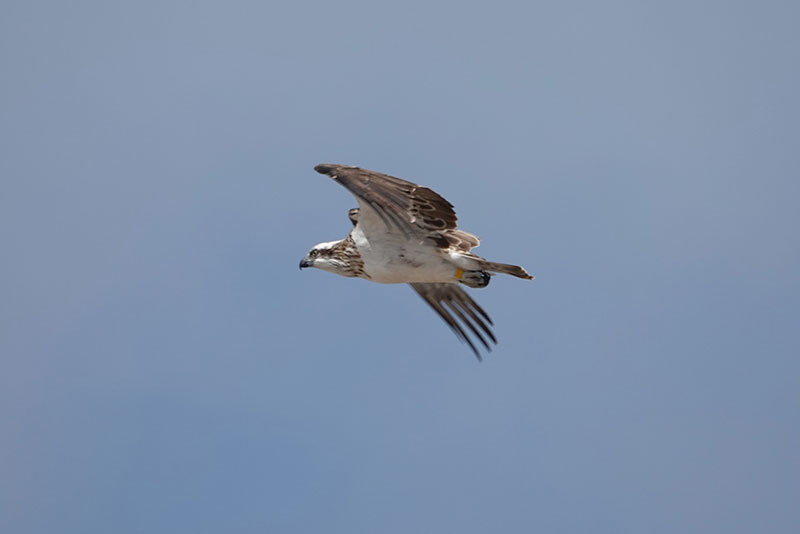

Will, male, 2022 – present day
Named after Wills Creek, the location of the conservation park where the artificial platform nest is located, Will fledged from the nest in early 2023 and has been seen occasionally around the Yorke Peninsula.
Band identification: yellow on left, blue on right
Harry, male, 2022 – status unknown
Named Harry, because Will’s brother should always be called Harry…
and identification: metal (silver) on left, purple on right
Charlie, female, 2023 – deceased
Charlie was given this name because it was the nickname of Yorke Peninsula conservationist Kent Treloar. Kent was a pioneer of the work on the peninsula to protect osprey and install artificial nesting platforms throughout the region, in partnership with local landcare groups, the state government and Friends of Osprey. Kent’s passion for the environment started at an early age and he was involved in landscape restoration initiatives throughout his life. Kent founded the Southern Yorke Peninsula Landcare group with locals in 1989 and remained chair of the group until shortly before his death in 2020.
Charlie the osprey had a brief but interesting life, being the only chick to fledge from the Price nest in the 2023/24 breeding season. After fledging she began an epic 200km flight which took her inland across the Murray-Darling Basin to where she succumbed, likely as a result of predation (made vulnerable through exhaustion) at Lake Hattah in Victoria in March 2024. While this was a sad outcome and we do not know what attracted Charlie inland, it is an example of discovering something we would otherwise not know as a result of the GPS tracking.
Maxine, female, 2024 – present day
Maxine fledged from the Price nest in early 2025. She is named after a local Price resident who grew up on a nearby farm and has spoken dearly about her memories of the 1940s when the sails of ketches (a type of boat) were seen at the local football ground sailing into Port Price from a long distance away. This is something that is barely imaginable in Wills Creek today.
Band identification: red on left, blue on right

Vincent, 2024 – present day
This bird fledged from the highly productive Price nest in early 2025. He is named after South Australia’s Gulf St Vincent, the body of water that Wills Creek, where the nest is found, feeds into. Named by Price locals, this moniker aims to promote the region wherever Vincent decides to call home in the future.
Band identification: red on left, green on right
Kangaroo Island nest

Heiri, male, 2022 – present day
Named for Department for Environment and Water Ecologist, Heiri Klein, who has been active in conservation on Kangaroo Island for many years and has supported the work of Friends of Osprey.
Heiri fledged from an ancient nest on the edge of the Cape Ganthaeum Wilderness Area on D’Estrees Bay in early 2023. This nest can be dated to at least the 1850s when it was sketched in the background of a drawing of the wreck of The Osmanli, a steamer which ran aground with 40 passengers and five crew in 1853.
Heiri has a tracker and has largely stayed close to home around D’Estrees Bay since fledging.
Point Davenport
Three young fledged from this nest in 2024. They have not been named and band colours have not yet been reported.
